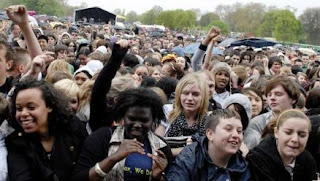"House rent parties were a facet of Harlem life even before the Depression. An outgrowth of parlor socials and church suppers held to raise funds for church needs, house rent parties aimed at helping dwellers of Harlem's railroad flats meet rents that skyrocketed monthly. Neighbors brought all kinds of food—fried chicken, baked ham, pig's feet, pork chops, gumbo, potato salad, and more—to which a supply of bootleg liquor was added. An admission was charged, and the piano players supplied the entertainment. "James P. Johnson, Willie "The Lion" Smith and Fats Waller became great favorites," Ellington recalled. "For ten bucks a shot, they somehow made appearances at three or four different rent parties on a good Saturday night," which did not end until sometime on Sunday.
It has been suggested that the house rent party grew in popularity as a reaction of blacks to their exclusion from Harlem clubs like the Cotton, Connie's Inn, Smalls' Paradise, etc. There was dancing—the bump, grind, monkey hunch. The pianist, assisted at times by a drummer who muffled his traps by covering the head with a blanket, sought to approximate orchestral effects, which, perhaps, helps explain the character of stride piano".
Source: The Jazz Age: Popular Music in the 1920s – Arnold Shaw (Oxford University Press, 1987)"Although house-rent parties once flourished in the black neighborhoods of Chicago, Detroit, Washington D.C., and other cities, they have become most closely associated with Harlem. During the 1920s and 1930s (and even into the 1940s), such parties formed the backbone of Harlem nightlife, and became for many working people not only an enjoyable and affordable way to dance and socialize but also an economic necessity. For the reasonable admission price of between ten cents and a dollar, plus the cost of liquor and food, guests could dance, drink, flirt, and gamble, while the hosts collected enough money to pay the landlord for another month.
The house-rent party evolved out of traditions that were several generations old by the beginning of the Harlem Renaissance. Since the late nineteenth century, African-American families in the rural south had enjoyed Saturday night barbecues and fish fries, complete with music and dancing, at events called "frolics" or "breakdowns." By the turn of the twentieth century, African-Americans in southern cities were throwing dance parties expressly to raise money. Dozens of couples would cram into tiny apartments, and the sometimes painful results of dancing in such confined spaces led to the term "shin-digs" to describe these events, though they were also referred to as "stomps," "boogies," "breakdowns," "skiffles," "scuffles," "struggles," "shake-me-downs," "chitterling rags," and "struts."
To prepare for a rent party, hosts would clear all furniture (except for the piano) from the front rooms of the apartment, take up the rugs, replace regular lightbulbs with more sensuous colored ones, and sometimes rent folding chairs from a local undertaker. Some hosts would even hire "home defense officers" (HDOs), to bounce unwelcome guests and squelch incipient brawls. The highlight of any rent party was the music, often provided by a single piano player, a series of pianists, or even a three-or four-piece musical ensemble. Well-known pianists such as "Fats" Waller, James P. Johnson, and Willie "the Lion" Smith regularly made the rounds at rent parties, where musicians competed in "cutting contests" to determine who was the most talented. Bootleg liquor, usually homemade corn whiskey (called "King Kong") or bathtub gin, was sold by the pint or in quarter-pint portions called "shorties." For an additional price, guests could purchase southern-style meals that usually included some combination of hoppin' John, fried chicken, fried fish, chitterlings, mulatto rice (rice and tomatoes), gumbo, chili, collard greens, potato salad, and sweet potato pone. The party would often last until dawn, or until someone summoned the Black Maria (the police patrol wagon) to break it up.
In order to attract a large number of paying guests, hosts advertised their parties using "rent party tickets." Often, they enlisted the help of the "Wayside Printer," a middle-aged white man who walked the streets of Harlem with his portable press. For a modest fee, he stamped the party information onto tickets about the size of a business card. Interestingly, these tickets always identified rent parties using such terms as "Social Party," "Social Whist Party," "Parlor Social," or "Matinee Party." Other, less elevated terms included "Too Terrible Party," "Boogie," and "Tea Cup Party." Tickets often incorporated popular slang phrases, lyrics from current songs, or bits of poetry. One ticket from 1927 implored: "Save your tears for a rainy day, / We are giving a party where you can play / With red-hot mammas and too bad She-bas / Who wear their dresses above their knees / And mess around with whom they please." Another reasoned: "You Don't Get Nothing for Being an Angel Child, So You Might As Well Get Real Busy and Real Wild."
Hosts would distribute these tickets to friends, neighbors, and even strangers on the street corner. Sometimes, hosts targeted a specific population, such as Pullman porters, interstate truck drivers, or black tourists. Other hosts simply tucked the tickets into elevator grilles or apartment windows. Drumming up a good crowd was important, for competition was fierce; as many as twelve parties in a single block and five in an apartment building, simultaneously, were not uncommon in Harlem during the 1920s. Although rent parties raged every night of the week, the most popular evening was Saturday, since most day laborers were paid on Saturday and few had to work on Sunday. The next favorite party night was Thursday, when most sleep-in domestic workers were off-duty".
Source: Encyclopedia of the Harlem Renaissance









